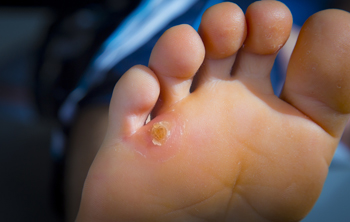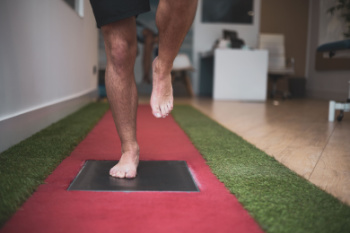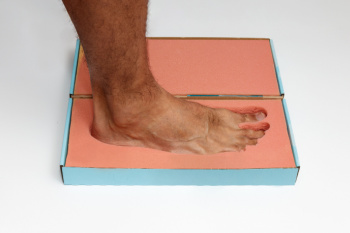Items filtered by date: May 2024
Heel Pain Can Be Treated!
Differences Between Foot Corns and Calluses

Calluses and corns on the feet are skin conditions that develop as a protective response to prolonged friction and pressure. Although they might appear similar, there are key differences between them. Calluses are broad, evenly thickened areas of skin that typically form on the soles of the feet. They can arise from activities that place repeated stress on this area, such as walking or running in poorly fitting shoes. Calluses have a hard, yellowish appearance and can cause discomfort or pain, making it difficult to walk. In contrast, corns are smaller, more concentrated areas of thickened skin, usually found on the tops and sides of toes. They develop due to the pressure and friction from wearing tight or ill-fitting shoes. Corns feature a dense, central core and can be either hard or soft. Hard corns appear on the bony parts of the toes, while soft corns develop between the toes where moisture keeps them pliable. Both corns and calluses can cause significant pain and discomfort and can lead to infection if not properly managed. Persistent or painful corns and calluses may warrant medical attention. If corns or calluses on your feet are causing you discomfort, it is suggested that you schedule an appointment with a podiatrist for targeted treatment.
If you have any concerns regarding your feet and ankles, contact Brandon M. Zuklie, DPM of New Jersey. Our doctor will treat your foot and ankle needs.
Corns: What Are They? and How Do You Get Rid of Them?
Corns can be described as areas of the skin that have thickened to the point of becoming painful or irritating. They are often layers and layers of the skin that have become dry and rough, and are normally smaller than calluses.
Ways to Prevent Corns
There are many ways to get rid of painful corns such as wearing:
- Well-fitting socks
- Comfortable shoes that are not tight around your foot
- Shoes that offer support
Treating Corns
Treatment of corns involves removing the dead skin that has built up in the specific area of the foot. Consult with Our doctor to determine the best treatment option for your case of corns.
If you have any questions please feel free to contact our offices located in Piscataway, Jamesburg, and Branchburg, NJ . We offer the newest diagnostic and treatment technologies for all your foot and ankle needs.
The Prevalence of Foot Pain

Foot pain is a pervasive ailment affecting people of all ages and lifestyles. It manifests in various forms and can be felt anywhere in the foot, from the toes to the heel. Unfortunately, foot care is frequently neglected, leading to greater discomfort and potential complications. Foot discomfort is particularly pronounced among the elderly and women, which may be due to the aging process and footwear choices. The role of footwear cannot be overstated in the context of foot pain. Wearing ill-fitting shoes, high heels, or footwear with inadequate support can contribute significantly to discomfort and even chronic conditions like plantar fasciitis or bunions. Conversely, proper footwear selection, including supportive insoles or custom orthotics when necessary, can alleviate pressure points and promote overall foot health. If you suffer from persistent foot pain, it is suggested that you schedule an appointment with a podiatrist for a proper diagnosis and treatment.
Foot Pain
Foot pain can be extremely painful and debilitating. If you have a foot pain, consult with Brandon M. Zuklie, DPM from New Jersey. Our doctor will assess your condition and provide you with quality foot and ankle treatment.
Causes
Foot pain is a very broad condition that could be caused by one or more ailments. The most common include:
- Bunions
- Hammertoes
- Plantar Fasciitis
- Bone Spurs
- Corns
- Tarsal Tunnel Syndrome
- Ingrown Toenails
- Arthritis (such as Gout, Rheumatoid, and Osteoarthritis)
- Flat Feet
- Injury (from stress fractures, broken toe, foot, ankle, Achilles tendon ruptures, and sprains)
- And more
Diagnosis
To figure out the cause of foot pain, podiatrists utilize several different methods. This can range from simple visual inspections and sensation tests to X-rays and MRI scans. Prior medical history, family medical history, and any recent physical traumatic events will all be taken into consideration for a proper diagnosis.
Treatment
Treatment depends upon the cause of the foot pain. Whether it is resting, staying off the foot, or having surgery; podiatrists have a number of treatment options available for foot pain.
If you have any questions, please feel free to contact our offices located in Piscataway, Jamesburg, and Branchburg, NJ . We offer the newest diagnostic and treatment technologies for all your foot care needs.
The Running Gait Cycle

The running gait cycle, a complex sequence of movements, plays a vital role in the biomechanics of the feet. As runners progress through each phase of the gait cycle, their feet undergo a series of motions aimed at generating propulsion and absorbing shock. The cycle typically consists of stance and swing phases. During the stance phase, the foot strikes the ground, starting with the initial contact, followed by mid-stance and propulsion, where the foot pushes off to propel the body forward. Throughout these phases, the foot experiences various biomechanical forces, including pronation, or inward rolling, and supination, which is outward rolling to adapt to the terrain and distribute pressure evenly. In the swing phase, the foot lifts off the ground, preparing for the next stride. Understanding the intricacies of the running gait cycle and how it influences your foot biomechanics is essential for optimizing performance, preventing injuries, and selecting appropriate footwear for runners of all levels. If you are looking for a gait analysis, or if you have endured a foot or ankle injury from running, it is suggested that you visit a podiatrist.
If you have any concerns about your feet, contact Brandon M. Zuklie, DPM from New Jersey. Our doctor can provide the care you need to keep you pain-free and on your feet.
Biomechanics in Podiatry
Podiatric biomechanics is a particular sector of specialty podiatry with licensed practitioners who are trained to diagnose and treat conditions affecting the foot, ankle and lower leg. Biomechanics deals with the forces that act against the body, causing an interference with the biological structures. It focuses on the movement of the ankle, the foot and the forces that interact with them.
A History of Biomechanics
- Biomechanics dates back to the BC era in Egypt where evidence of professional foot care has been recorded.
- In 1974, biomechanics gained a higher profile from the studies of Merton Root, who claimed that by changing or controlling the forces between the ankle and the foot, corrections or conditions could be implemented to gain strength and coordination in the area.
Modern technological improvements are based on past theories and therapeutic processes that provide a better understanding of podiatric concepts for biomechanics. Computers can provide accurate information about the forces and patterns of the feet and lower legs.
Understanding biomechanics of the feet can help improve and eliminate pain, stopping further stress to the foot.
If you have any questions please feel free to contact our offices located in Piscataway, Jamesburg, and Branchburg, NJ . We offer the newest diagnostic and treatment technologies for all your foot and ankle needs.
How Custom Orthotics Can Help Arthritis Pain

Arthritis, whether rheumatoid or osteoarthritis, can significantly impair one's quality of life, particularly when it affects the feet. Constant foot pain can hinder mobility, limit activities, and lead to physical and emotional challenges. However, custom-made orthotics can help those grappling with arthritis-related foot discomfort. Orthotics are tailor-made shoe inserts designed to alleviate pressure on specific areas of the foot, redistributing weight and promoting proper alignment. By providing support and cushioning, orthotics reduce pain and discomfort, allowing individuals to move more freely and engage in daily activities. Moreover, orthotics can help reduce the need for pain medication, offering a non-invasive alternative for managing arthritis symptoms. By improving gait and reducing strain on joints, orthotics can also play a significant role in preventing the progression of arthritis, helping individuals maintain their mobility and independence for longer. If you suffer from arthritic symptoms of the feet, it is suggested that you schedule an appointment with a podiatrist for relief options.
If you are having discomfort in your feet and would like to try orthotics, contact Brandon M. Zuklie, DPM from New Jersey. Our doctor can provide the care you need to keep you pain-free and on your feet.
What Are Orthotics?
Orthotics are inserts you can place into your shoes to help with a variety of foot problems such as flat feet or foot pain. Orthotics provide relief and comfort for minor foot and heel pain but can’t correct serious biomechanical problems in your feet.
Over-the-Counter Inserts
Orthotics come in a wide variety of over-the-counter inserts that are used to treat foot pain, heel pain, and minor problems. For example, arch supports can be inserted into your shoes to help correct overarched or flat feet, while gel insoles are often used because they provide comfort and relief from foot and heel pain by alleviating pressure.
Prescription Orthotics
If over-the-counter inserts don’t work for you or if you have a more severe foot concern, it is possible to have your podiatrist prescribe custom orthotics. These high-quality inserts are designed to treat problems such as abnormal motion, plantar fasciitis, and severe forms of heel pain. They can even be used to help patients suffering from diabetes by treating foot ulcers and painful calluses and are usually molded to your feet individually, which allows them to provide full support and comfort.
If you are experiencing minor to severe foot or heel pain, it’s recommended to speak with your podiatrist about the possibilities of using orthotics. A podiatrist can determine which type of orthotic is right for you and allow you to take the first steps towards being pain-free.
If you have any questions please contact our offices located in Piscataway, Jamesburg, and Branchburg, NJ . We offer the newest diagnostic and treatment technologies for all your foot and ankle needs.


